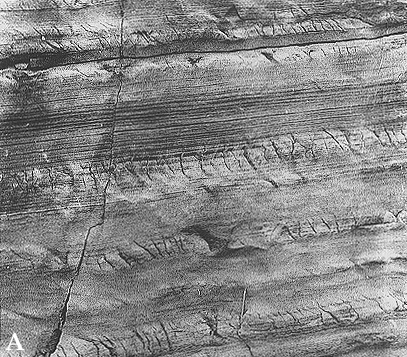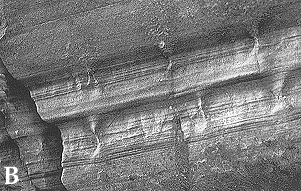

X (bow-tie) and Y-shaped dewatering structures
Plate 115


X (bow-tie) and Y-shaped dewatering structures
Plate 115
In plate 115, a turbidite megabed has been presented in panoramic view; here are two close-ups of it showing plane-parallel lamination and peculiar dewatering structures, with a pencil for scale. It can be seen that laminae are not equally developed: they are fainter in some levels, well defined in others. Moreover, short "joints" are present in some laminasets, absent in others. They are not perfectly rectilinear, and part of them has a Y or X pattern. At first sight, these features, here described for the first time, look like tectonic structures, but one wonders why they do not cross the whole bed. This is rather puzzling. Upon closer inspection, most X- and Y-shaped "fractures" do not appear as fissures but as projecting, more cemented "ribs" (B).
The ribs can be interpreted more or less like pillars, i.e., as dewatering structures. This sounds reasonable, if you consider that each level with ribs rests upon a level with semiobliterated structures, well fitting the role of partly liquefied source bed for escaping water. Well-laminated levels had a relative rigidity because of tight grain packing, and were punctured by discrete injections.
The X-shaped structures, resembling bow ties, sand-glasses, or a variety of Italian pasta, seem to be formed by a lower funnel where water converged, and an upper one where divergence and dispersion occurred.
Contessa Bed, Marnoso-arenacea Formation, northern Apennines.